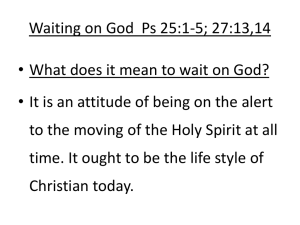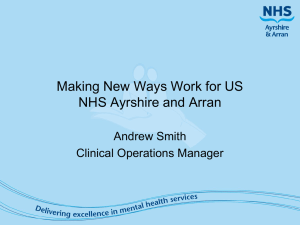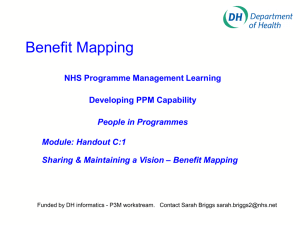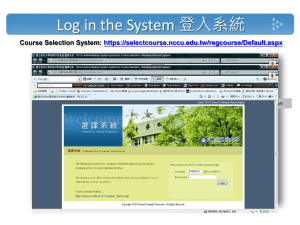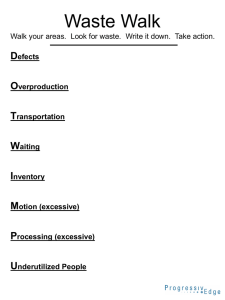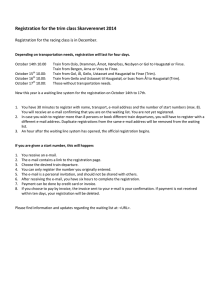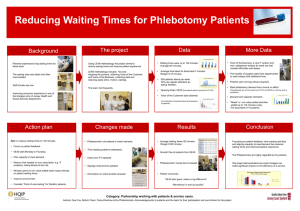Patient - Western Canada Waiting List Project
advertisement
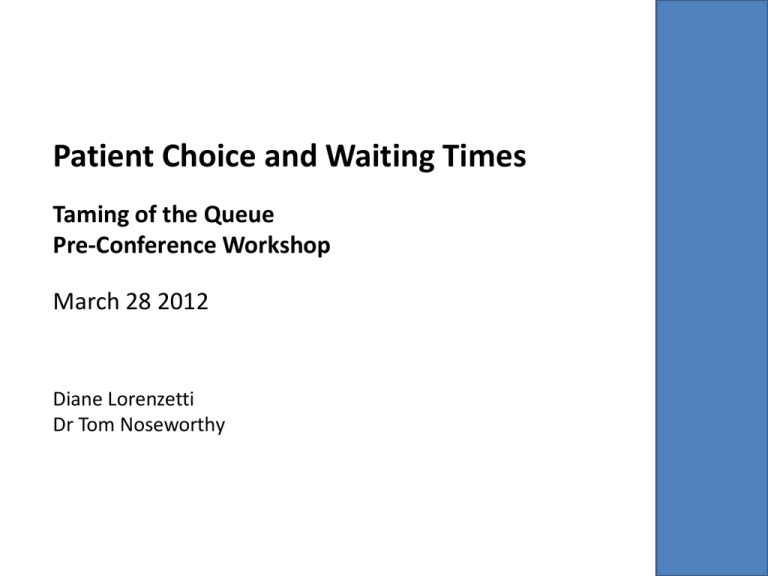
Patient Choice and Waiting Times Taming of the Queue Pre-Conference Workshop March 28 2012 Diane Lorenzetti Dr Tom Noseworthy Choice in Health Care General Practitioner Hospital Specialist Treatment Benefits of choice Empowers patients Increases access Encourages market competition Efficiencies Quality of care Waiting times History of Patient Choice Pre 1980s: Patient choice of specialist or hospital is an implicit right in Australia, Belgium, England, France, Germany, and the Netherlands. In many other countries patients have the right to choose their general practitioner 1980s: Patient choice legislated in Denmark, England, New Zealand, Norway and Sweden Early 1990s: Patient choice schemes introduced in response to long waiting times in Denmark, England, Norway and Sweden 2000s: European Union Commission supports patients’ right to receive care in any member state 2006: Choose & Book online patient booking system introduced in the UK to facilitate access to choice of specialist, appointment date and time Canadian Experience Choice of general practitioner within province of residence Isolated initiatives to facilitate faster access to specialists/hospitals for patient groups (eg: Ontario Cardiac Care Network) or services (eg: radiology in Nova Scotia) No concerted effort to implement broader patient choice schemes Studies of effectiveness primarily limited to patient stated preference surveys (eg: hip and knee patients in Saskatchewan) Does patient choice reduce waiting times for scheduled services? Factors which impact on patient choice Other Initiatives Patient-level CHOICE System-level Provider-level Patient-level factors affecting willingness to exercise choice Relationships Pain Reputations Recommendations Decision support Quality of life Chronic/multiple health issues Choice CHOICE Travel Waiting times Aftercare Appointment dates Socioeconomics Arthroplasty Patients in Saskatchewan In a 2006 survey of 1200 arthroplasty patients in Saskatchewan, 40% of those waiting for surgery and 35% of those who had had surgery would consider switching surgeons for shorter wait times In a similar survey of 303 patients who had undergone surgery, if given a choice of switching surgeons for shorter waiting times: 68% would not switch 15% would switch 17% uncertain Provider/system-level responses to patient choice WT increase at a greater rate for providers with low waits than reduces for providers with high waits Where patient demand outstrips capacity there is little incentive to reduce waiting times Choice CHOICE Fixed budgets can be a disincentive for providers to increase activity (reduce waiting times) or accept very ill patients Reduced waiting times may encourage providers to attract more patients Patient choice in practice Norway Patient Bridge Pilot Project (2000) Patients on waiting lists could transfer to private hospitals in Sweden, Denmark and Germany Expenses related to travel were subsidized Project resulted in reduction in waiting times for patients who travelled abroad and those who remained at home Patients guaranteed aftercare at home hospital more willing to travel 50% of public hospitals chose NOT to recruit patients for the project Norway Patients’ Rights Act (2001-) Patients’ right to receive elective care at any hospital, irrespective of geography In 2004, this right was extended to private hospitals under contract to a Regional Health Authority A 2004 study determined that, on average, patients who chose to travel for care had their procedures 11 weeks sooner than those who did not choose to travel UK Patient Choice Pilots (2002-2003) Patients in London and Manchester waiting more than 6 months for an operation (including: ophthalmology, ear, nose & throat, general surgery, and orthopedics) Patients throughout England waiting more than 6 months for cardiac surgery Administrators purchased services from designated hospitals with capacity to take on additional patients Patient care advisors assisted patients in obtaining information, choosing, and booking appointments Linkages between hospitals ensured adequate aftercare Transportation to alternate hospitals provided free of charge. One relative could travel and remain with a patient during their stay NHS Choose & Book (2006-) An electronic booking system for outpatient appointments Since 2006, patients in the UK referred for an elective procedure by their GP have been able to choose secondary care providers, appointment dates and times Money follows the patient (case-based hospital payment) Private hospitals were able to compete for NHS patients Choose & Book was introduced alongside 18 week referral to treatment targets for scheduled services and increases in health spending Effectiveness of Choose & Book Many patients reported not having been aware of or offered a choice by their GP (51% in a 2010 King’s Fund Report) 69% of patients who were offered choice chose local providers GPs were influential in directing patients’ choice at referral GPs found the electronic booking system time consuming Impact of choice varied and was both dependent on proximity of similar providers and the services required Factors Influencing NHS Patients’ Hospital Choice (2009) Cleanliness 2.6 Quality of care 2.5 Hospital reputation 2.1 Length of waiting list 2.1 Travel distance 2 Personal experience 2 Appointment Time 1.8 Consultant of choice 1.7 Family/Friends Experiences 1.5 Travel costs 1 0 0.5 1 1.5 2 Not Important (0) to Very Important (3) 2.5 3 Patient Choice and Waiting Times Uptake of patient choice varies Little data linking choice to waiting time reductions (outside of pilot studies) Challenging to tease out the effects of choice from other initiatives (eg: waiting time targets) Equity & Patient Choice Culture Physical mobility Flexible employment Family responsibilities Comprehension Travel costs Travel distance Policy Implications Patient choice may be a means of reducing waiting times for scheduled services……….HOWEVER Choice should be considered as but one component of a comprehensive strategy Choice appears to work best when introduced alongside supportive policies Patient and provider buy-in is key Patient uptake depends on a variety of factors, only one of which is waiting times Choice should be implemented so as not to negatively impact patient equity Questions/Comments Diane Lorenzetti Department of Community Health Sciences University of Calgary dllorenz@ucalgary.ca


